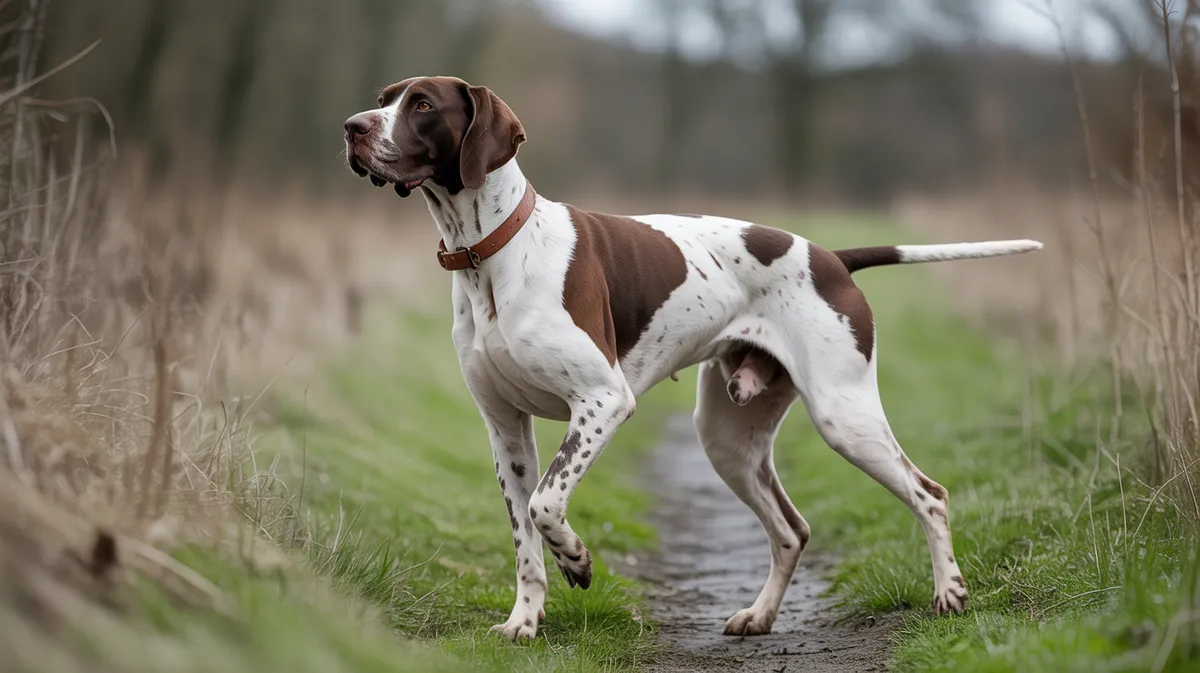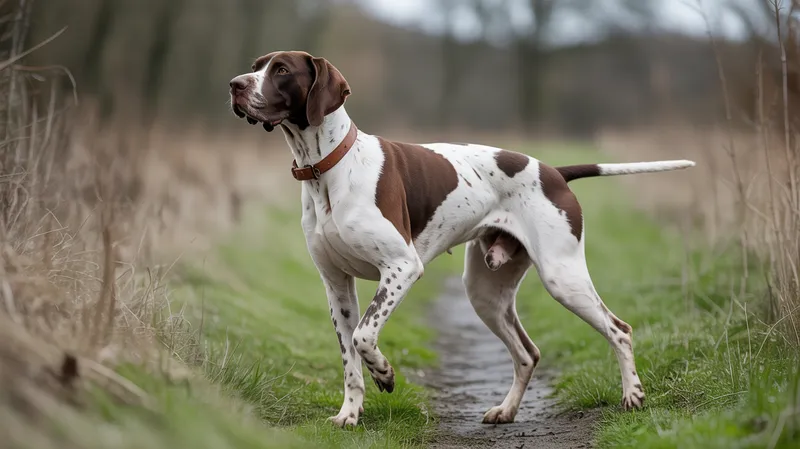
Pointer (English Pointer)
Canis lupus familiaris

Meet the Pointer (English Pointer)
The Pointer, often called the English Pointer, is a medium-to-large breed of dog renowned for its athletic build, keen sense of smell, and strong hunting instincts. Developed in England for locating game birds, Pointers are easily recognized by their graceful stance and the characteristic pose of standing still with their nose pointing towards game. They are highly energetic, intelligent, and require ample exercise, making them excellent companions for active families and hunters alike. Their affectionate and even temperament also make them good family pets when given enough mental and physical stimulation.
Classification
Mammal
Habitat
Domestic, often in rural or countryside environments where hunting occurs
Diet
Omnivore
Lifespan
12-17 years
Conservation
Domesticated (Not Evaluated)
Weight
20-34 kg (44-75 lbs)
📖Fascinating Facts
Exceptional Scent Detectors
Pointers have an extraordinary sense of smell, which allows them to locate birds and other game from remarkable distances.
Endurance Athletes
With their lean build and muscular legs, Pointers are capable of running for long distances at a steady pace without tiring easily.
Historic Inspiration
Pointers have been featured in numerous works of art and literature, symbolizing grace and the tradition of hunting in English culture.
📋Detailed Description
The English Pointer is a medium-to-large breed, typically weighing between 20–34 kg (45–75 lbs) and standing 58–71 cm (23–28 in) at the shoulder. Its anatomy is defined by a lean, muscular frame, deep chest, and long legs, all contributing to its remarkable speed and stamina in the field. The breed’s head is chiseled with a pronounced stop, long muzzle, and wide nostrils optimized for scent detection. The coat is short, smooth, and dense, usually white with distinctive liver, lemon, black, or orange markings. Pointers are renowned for their 'pointing' stance—a rigid posture with one foreleg raised, tail extended, and nose directed toward game, a behavior rooted in their specialized hunting role. Socially, Pointers are highly people-oriented, forming strong bonds with their families and often displaying gentle, affectionate temperaments. They are intelligent, quick learners, and thrive on mental and physical stimulation, requiring significant daily exercise to prevent boredom-related behaviors. In group settings, Pointers are generally sociable with other dogs, though their strong prey drive can be triggered by small animals. Their reproductive cycle is typical of medium-to-large breeds, with litters averaging 6–8 puppies. Unique adaptations such as their acute olfactory system, streamlined physique, and high endurance make them exceptional field dogs and companions for active households.
💡 Did you know?
Despite their hunting heritage, Pointers are gentle and affectionate at home, and many are known to be couch potatoes when not actively working or exercising.
🔬Research & Sources
🎭Behavior & Social Structure
English Pointers are energetic and alert, displaying a strong instinctual drive to locate and indicate the presence of game birds. Their hunting behavior is characterized by quartering the field in wide, sweeping patterns, using their keen sense of smell to detect scent particles carried by the wind. Upon locating game, they freeze in a classic pointing pose, remaining motionless until the handler approaches. Feeding behavior is typical of domestic dogs, with a diet consisting of commercial dog food supplemented by proteins, fats, and carbohydrates. Socially, Pointers are affectionate with humans and generally tolerant of other dogs, though early socialization is important to mitigate shyness or overexuberance. Daily routines should include vigorous exercise—such as running, agility, or fieldwork—to satisfy their high activity needs. Without adequate stimulation, they may develop destructive behaviors or anxiety. Pointers are also known for their sensitivity and responsiveness to positive reinforcement training methods.
👶Reproduction & Life Cycle
The English Pointer reaches sexual maturity between 12–18 months. Females typically come into estrus twice a year, with the optimal breeding age being 2–5 years. Mating is usually managed by breeders to ensure genetic health and temperament. The gestation period averages 63 days, after which litters of 6–8 puppies are born. Neonatal care is provided primarily by the dam, who nurses and cleans the puppies for the first 3–4 weeks. Breeders often assist with early socialization, handling, and exposure to environmental stimuli to promote stable temperaments. Weaning occurs gradually at 4–6 weeks, and puppies are generally ready for adoption at 8–10 weeks. There is no defined breeding season, as domestic dogs can reproduce year-round, but reputable breeders often plan litters to coincide with favorable conditions for puppy development.
🛡️Adaptations & Survival
The Pointer’s most notable adaptation is its highly developed olfactory system, with an estimated 220 million scent receptors, allowing it to detect faint odors over long distances. Its streamlined body, deep chest, and long legs are specialized for endurance running, enabling it to cover large areas of terrain efficiently. The short, dense coat provides protection from brush and weather without overheating during exertion. The breed’s characteristic pointing behavior is a result of both instinct and selective breeding, optimizing its role as a hunting companion. Behavioral adaptations include a high degree of trainability, responsiveness to human cues, and the ability to work cooperatively in teams with handlers and other dogs. Their acute hearing and visual acuity further enhance their effectiveness in the field.
📚Research Sources
🎨Cultural Significance
The English Pointer has played a significant role in British and European hunting culture since the 17th century, symbolizing elegance, athleticism, and partnership between human and dog. Its image is frequently depicted in sporting art, literature, and heraldry. The breed’s pointing stance has become an iconic representation of hunting dogs in general. Pointers have also contributed to the development of other pointing breeds, such as the German Shorthaired Pointer. While not associated with mythology, the breed’s reputation for loyalty and skill has made it a favored subject in rural traditions and field trials. In modern times, Pointers are celebrated in dog shows, field competitions, and as therapy and search-and-rescue dogs.
🔬Recent Research & Discoveries
Recent genetic studies have explored the Pointer’s ancestry, confirming its development from Spanish Pointers crossed with local British breeds in the 18th century. Ongoing research focuses on olfactory genetics, seeking to understand the molecular basis of their scenting abilities. Studies on canine cognition have highlighted the Pointer’s problem-solving skills and responsiveness to human gestures, making them a model for research on dog-human communication. Veterinary research continues to monitor breed-specific health issues, with advances in genetic screening helping to reduce the incidence of inherited disorders. Behavioral studies have examined the impact of early socialization and training on hunting performance and companion suitability.
🎥Wildlife Videos

Vet Helps Pregnant Dog Give Birth To 10+ Puppies 🥹 8hrs Natural Birth | Bondi Vet Clips | Bondi Vet
No one knew Jewel was pregnant! Get ready for a long night of anxiety, sadness and ultimately joy as Dr Chris helps Jewel ...
Bondi Vet

English Pointer finds a big Sambar deer stag
Maximising your sambar deer hunting success by buying a pointing dog to find deer really comes down to understanding how to ...
Ultimate Hunting Australia

THE ENGLISH POINTER No2.The Evolution. Hunting Working, Morphology, History
POINTING DOGS N07 A TSTV Production. Scenario & Directing Giannis Christogiannis 12 years after our first movie regarding ...
ioannis christogiannis

dogs hurry for hunt dogs, hunting dog, village dogs, pointer dog,
Hunting dogs Real,
wildlife animals of sindh

Champion Bird Dogs Pointers, Setters & Spaniels 1940 Pictorial Films; Hunting Dogs, Retrievers
1940 Pictorial Films.
Military History TV

Pointer Dog ! Shikari Dog. #animal english pointer,
pointer dog ! shikari dog. watch live hunting video. so beautiful moments of hunting green lands and so mich fun of dogs in the ...
Animals and birds of sindh
🌍Habitat Information
The Pointer (English Pointer) typically inhabits Domestic, often in rural or countryside environments where hunting occurs environments. Pointer (English Pointer)s have adapted to their environments with specialized features and behaviors.
Primary Habitat:
Domestic, often in rural or countryside environments where hunting occurs
More detailed habitat information will be available soon.
🛡️Conservation Status
The Pointer (English Pointer) is currently classified as Domesticated (Not Evaluated). Conservation efforts are crucial for preserving this species for future generations.
Common Threats:
- 🏠Habitat loss and fragmentation
- 🌡️Climate change impacts
- 🎯Hunting and poaching
- 🏭Human-wildlife conflict
⚠️Threats & Conservation Challenges
As a domesticated breed, the English Pointer does not face natural threats or conservation challenges in the wild. However, the breed is subject to issues common in purebred dogs, such as genetic disorders (hip dysplasia, progressive retinal atrophy, and epilepsy), which can be exacerbated by irresponsible breeding practices. Overpopulation in some regions due to indiscriminate breeding can lead to abandonment or shelter surrender. Human impact is primarily positive, as the breed is maintained and propagated through selective breeding for hunting and companionship. Population trends are stable, with the breed remaining popular among hunters and active families, though less common than some other sporting breeds.
🔬Scientific Classification
Scientific Name
Canis lupus familiaris
Classification Hierarchy
🔍 About Taxonomic Classification
Taxonomic classification is a hierarchical system used by scientists to classify and organize living organisms based on shared characteristics and evolutionary relationships.
The system moves from broad categories (Kingdom) to increasingly specific ones, with each animal's scientific name typically consisting of its Genus and species.
📝Community Notes
Share your observations and insights about the Pointer (English Pointer) with our community of wildlife enthusiasts.
Join Our Community
Sign in to share your observations and connect with fellow wildlife enthusiasts.
Sign In to ContributeNo community notes yet
Be the first to share your observations about the Pointer (English Pointer)!
Explore Pointer (English Pointer)
Select a tab above to learn more about this amazing animal.
📸Photo Gallery
No photos available for this animal yet.
🌟Discover More Wildlife
Continue your journey of discovery with more fascinating animals from our database
